Philippine Sea order of battle
The Battle of the Philippine Sea was fought 19-20 June 1944 in the waters west of the Mariana Islands by elements of the Imperial Japanese Navy's Combined Fleet and of the United States Navy's Pacific Fleet. The battle exacted a terrible toll from the Japanese naval air arm, costing them most of their few remaining experienced pilots. The Combined Fleet was no longer capable of serious offensive operations after this engagement. Historian Samuel Eliot Morison characterized it this way:
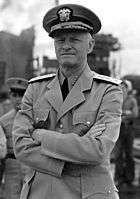
This was the greatest carrier battle of the war. The forces engaged were three to four times those in preceding actions like Midway, and victory was so complete that the Japanese could never again engage on such a scale. ... above all the skill, initiative, and intrepid courage of the young aviators made this day one of the high points in the history of the American spirit.[1]
Since the Japanese assumed the tactical offensive, their forces are listed first.
![]()
- Combat ships: 3 fleet carriers, 2 old fleet carriers, 4 light carriers, 2 new battleships, 3 old battleships, 7 heavy cruisers, 2 light cruisers, 34 destroyers, 6 oilers, 7 1st-class submarines, 17 2nd-class submarines
- Air units: 222 fighters, 113 dive bombers, 95 torpedo bombers
![]()
- Combat ships: 7 fleet carriers, 8 light carriers, 7 fast battleships, 8 heavy cruisers, 6 light cruisers, 4 anti-aircraft light cruisers, 70 destroyers
- Air units: 423 fighters, 233 dive bombers, 194 torpedo bombers, 23 night fighters
Ship losses during campaign
IJN: 2 fleet carriers, 1 old fleet carrier, 5 destroyers, 2 oilers, 4 1st-class submarines, 9 2nd-class submarines
USN: -none-
Aircraft losses
IJN: 243
USN: 130
Japanese order of battle
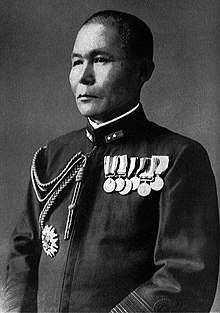
Mobile Fleet[2]
Vice Admiral Jisaburō Ozawa in Taihō
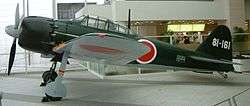
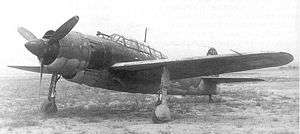

Van Force
Vice Admiral Takeo Kurita in Atago
Carrier Division 3 (Rear Admiral Sueo Obayashi):
- 3 light carriers
- Chitose
- Chiyoda
- Zuihō
- Air Unit
- 62 Mitsubishi A6M "Zeke" fighters
- 17 Nakajima B5N "Kate" torpedo bombers
- 9 Nakajima B6N "Jill" torpedo bombers
Battleship Division 1 (Vice Admiral Matome Ugaki):
Battleship Division 3 (Vice Admiral Yoshio Suzuki):
Cruiser Division 4 (Vice Admiral Kurita):
Screen (Rear Admiral Mikio Hayakawa in Noshiro):
"A" Force
Vice Admiral Ozawa


Carrier Division 1 (Vice Admiral Ozawa):
- 3 fleet carriers
- Taihō (sunk 19 June by internal explosion)
- Shōkaku (sunk 19 June by submarine)
- Zuikaku
- Air Unit
- 79 Mitsubishi A6M "Zeke" fighters
- 70 Yokosuka D4Y "Judy" dive bombers
- 7 Aichi D3A "Val" dive bombers
- 51 Nakajima B6N "Jill" torpedo bombers
Cruiser Division 5 (Rear Admiral Shintaro Hashimoto):
Screen (Rear Admiral Susumu Kimura in Yahagi):
- 1 light cruiser: Yahagi
- 9 destroyers
- 1 Asashio class (6 x 5 in. main battery): Asagumo
- 3 Kagerō class (6 x 5 in. main battery): Isokaze, Tanikaze (sunk 9 June by submarine), Urakaze
- 4 Akizuki class (8 x 3.9 in. main battery): Akizuki, Hatsuzuki, Wakatsuki, Shimotsuki
- 1 Mutsuki class (4 x 4.7 in. main battery): Minazuki (sunk 6 June by submarine)
"B" Force
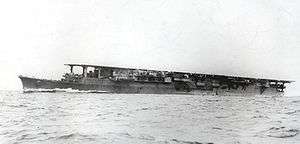
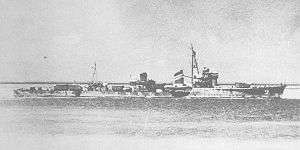
Rear Admiral Takaji Joshima
Carrier Division 2 (Rear Admiral Joshima):
- 2 converted fleet carriers: Jun'yō, Hiyō (sunk 19 June by air attack)
- 1 light carrier: Ryūhō
- Air Unit
- 81 Mitsubishi A6M "Zeke" fighters
- 27 Yokosuka D4Y "Judy" dive bombers
- 9 Aichi D3A "Val" dive bombers
- 18 Nakajima B6N "Jill" torpedo bombers
- Air Unit
- 1 old battleship: Nagato
- 1 heavy cruiser: Mogami
Screen:
- 9 destroyers
- 2 Asashio class (6 x 5 in. main battery): Michishio, Yamagumo
- 2 Kagerō class (6 x 5 in. main battery): Nowaki, Hamakaze
- 2 Yūgumo class (6 x 5 in. main battery): Hayashimo, Akishimo
- 4 Shiratsuyu class (5 x 5 in. main battery): Shiratsuyu (sunk 14 June following collision with Seiyo Maru), Shigure, Samidare, Harusame (sunk 8 June by air attack)

Supply Forces
1st Supply Force
- 4 oilers: Hayasui, Nichiei Maru, Kokuyo Maru, Seiyo Maru (sunk 14 June following collision with Shiratsuyu)
- 4 destroyers: Hibiki, Hatsushimo, Yūnagi, Tsuga
2nd Supply Force
Submarine Forces
Vice Admiral Takeo Takagi at Saipan
- 7 1st class submarines
- I-5 (sunk 19 July by depth charges), I-10 (sunk 4 July by depth charges), I-38, I-41, I-53, I-184 (sunk 19 June by aircraft), I-185 (sunk 22 June by depth charges)
- 17 2nd class submarines
- RO-36 (sunk 13 June by depth charges), RO-41, RO-42 (sunk 10 June by depth charges), RO-43, RO-44 (sunk 16 June by depth charges), RO-47, RO-68, RO-104 (sunk 23 May by depth charges), RO-105 (sunk 31 May by depth charges), RO-106 (sunk 22 May by depth charges), RO-108 (sunk 26 May by depth charges), RO-112, RO-113, RO-114 (sunk 17 June by depth charges), RO-115, RO-116 (sunk 23 May by depth charges), RO-117 (sunk 17 June by depth charges)
American order of battle
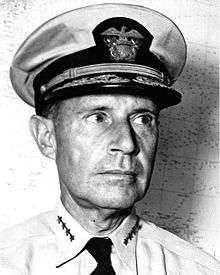
.jpg)
US Fifth Fleet[3]
Admiral Raymond A. Spruance in heavy cruiser Indianapolis
Task Force 58
Task Force 58 – Fast Carrier Forces
Vice Admiral Marc A. Mitscher in fleet carrier Lexington
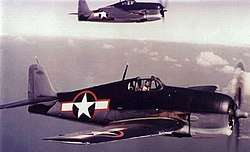
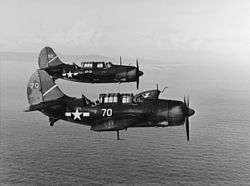

Task Group 58.1
Rear Admiral Joseph J. Clark
2 fleet carriers:
- Hornet (Capt. William D. Sample)
- Air Group 2 (Cmdr. Jackson D. Arnold)
- 36 F6F Hellcat fighters (Lt. Cmdr. W.A. Dean)
- 33 SB2C Helldiver dive bombers (Lt. Cmdr. G.B. Campbell)
- 4 TBF Avenger, 14 TBM Avenger torpedo bombers (Lt. Cmdr. L.M.D. Ford)
- 4 F6F-xN Hellcat night fighters (Lt. R.L. Reiserer)
- Air Group 2 (Cmdr. Jackson D. Arnold)
- Yorktown (Capt. R.E. Jennings)
- Air Group 1 (Cmdr. J.M. Peters)
- 41 F6F Hellcat fighters (Lt. Cmdr. B.M. Strean)
- 40 SB2C Helldiver, 4 SBD-5 Dauntless dive bombers (Lt. Cmdr. J.W. Runyan, USNR)
- 1 TBF Avenger, 16 TBM Avenger torpedo bombers (Lt. Cmdr. W.F. Henry)
- 4 F6F-xN Hellcat night fighters (Lt. A.C. Benjes)
- Air Group 1 (Cmdr. J.M. Peters)
2 light carriers:
- Belleau Wood (Capt. John Perry)
- Air Group 24 (Cmdr. E.M. Link)
- 26 F6F Hellcat fighters (Lt. Cmdr. Link)
- 3 TBF Avenger, 6 TBM Avenger torpedo bombers (Lt. R.M. Swensson)
- Air Group 24 (Cmdr. E.M. Link)
- Bataan (Capt. V.H. Schaeffer)
- Air Group 50 (Lt. Cmdr. J.C. Strange, USNR)
- 24 F6F Hellcat fighters (Lt. Cmdr. Strange)
- 9 TBM Avenger torpedo bombers (Lt. Cmdr. L.V. Swanson)
- Air Group 50 (Lt. Cmdr. J.C. Strange, USNR)
3 heavy cruisers (Rear Admiral Leo H. Thebaud):
2 anti-aircraft light cruisers[lower-alpha 1]: (Rear Admiral Thebaud):
14 destroyers (Capt. Clark):
- 9 Fletcher class (5 x 5 in. main battery): Bell, Boyd, Bradford, Brown, Burns, Charrette, Conner, Cowell, Izard
- 4 Gridley class (4 x 5 in. main battery): Craven, Gridley, Maury, McCall
- 1 Bagley class (4 x 5 in. main battery): Helm
Task Group 58.2
_at_sea_in_1945_(NH_42373).jpg)
.jpg)
_with_SBD_Oct_1943.jpg)
Rear Admiral Alfred E. Montgomery
2 fleet carriers:
- Bunker Hill (Capt. T.P. Jeter)
- Air Group 8 (Cmdr. R.L. Shifley)
- 37 F6F Hellcat fighters (Lt. Cmdr. W.M. Collins)
- 33 SB2C Helldiver dive bombers (Lt. Cmdr. J.D. Arbes)
- 13 TBF Avenger, 5 TBM Avenger torpedo bombers (Lt. Cmdr. K.F. Musick)
- 4 F6F-xN Hellcat night fighters (Lt. Cmdr. E.P. Aurand)
- Air Group 8 (Cmdr. R.L. Shifley)
- Wasp (Capt. C.A.F. Sprague)
- Air Group 14 (Cmdr. W.C. Wingard)
- 34 F6F Hellcat fighters (Lt. Cmdr. E.W. Biros, USNR)
- 32 SB2C Helldiver dive bombers (Lt. Cmdr. J.D. Blitch)
- 18 TBF Avenger torpedo bombers (Lt. Cmdr. H.S. Roberts, USNR)
- 4 F6F-xN Hellcat night fighters (Lt. J.H. Boyum)
- Air Group 14 (Cmdr. W.C. Wingard)
2 light carriers:
- Cabot (Capt. S.J. Michael)
- Air Group 31 (Lt. Cmdr. R.A. Winston)
- 24 F6F Hellcat fighters (Lt. Cmdr. Winston)
- 1 TBF Avenger, 8 TBM Avenger torpedo bombers (Lt. E.E. Wood, USNR)
- Air Group 31 (Lt. Cmdr. R.A. Winston)
- Monterey (Capt. S.H. Ingersoll)
- Air Group 28 (Lt. Cmdr. R.W. Mehle, USNR)
- 21 F6F Hellcat fighters (Lt. Cmdr. Mehle)
- 8 TBF Avenger torpedo bombers (Lt. Cmdr. R.P. Gift, USNR)
- Air Group 28 (Lt. Cmdr. R.W. Mehle, USNR)
3 light cruisers (Rear Admiral L.T. Dubose):
12 destroyers:
- 9 Fletcher class (5 x 5 in. main battery): Hickox, Hunt, Lewis Hancock, Marshall, Miller, Owen, Stephen Potter, The Sullivans, Tingey
- 3 Farragut class (4 x 5 in. main battery): Dewey, Hull, MacDonough
Task Group 58.3
_underway_at_sea_on_22_November_1943.jpg)
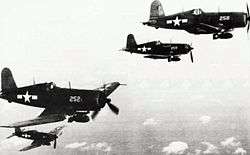
_underway_off_California_on_25_January_1944_(80-G-215947).jpg)
Rear Admiral John W. Reeves
2 fleet carriers:
- Enterprise (Capt. M.B. Gardner)
- Air Group 10 (Cmdr. W.R. Kane)
- 31 F6F Hellcat fighters (Lt. R.W. Schumann)
- 21 SBD Dauntless dive bombers (Lt. Cmdr. James D. Ramage)
- 9 TBF Avenger, 5 TBM Avenger torpedo bombers (Lt. Cmdr. W.I. Martin)
- 3 F4U Corsair night fighters (Lt. Cmdr. R.E. Harmer)
- Air Group 10 (Cmdr. W.R. Kane)
- Lexington (Capt. E.W. Litch)
- Air Group 16 (Cmdr. E.M. Snowden)
- 37 F6F Hellcat fighters (Lt. Cmdr. Ralph Weymouth)
- 34 SBD Dauntless dive bombers (Lt. Cmdr. Ralph Weymouth)
- 17 TBF Avenger, 1 TBM Avenger torpedo bombers (Lt. Cmdr. N.A. Sterrie, USNR)
- 4 F6F-xN Hellcat fighters (Lt. W.H. Abercrombie, USNR)
- Air Group 16 (Cmdr. E.M. Snowden)
2 light carriers:
- San Jacinto (Capt. H.M. Martin)
- Air Group 51 (Lt. Cmdr. C.L. Moore)
- 24 F6F Hellcat fighters (Lt. Cmdr. Moore)
- 6 TBF Avenger, 2 TBM Avenger torpedo bombers (Lt. Cmdr. D.J. Melvin)
- Air Group 51 (Lt. Cmdr. C.L. Moore)
- Princeton (Capt. W.H. Buracker)
- Air Group 27 (Lt. Cmdr. E.W. Wood – KIA)
- 24 F6F Hellcat fighters (Lt. Cmdr. Wood)
- 9 TBM Avenger torpedo bombers (Lt. Cmdr. S.M. Haley, USNR)
- Air Group 27 (Lt. Cmdr. E.W. Wood – KIA)
1 heavy cruiser:
- Indianapolis (Capt. E.R. Johnson)
3 light cruisers:
- Montpelier (Capt. H.D. Hoffman), Cleveland (Capt. A.G. Shepard), Birmingham (Capt. T.B. Inglis)
1 anti-aircraft light cruiser[lower-alpha 2]:
- Reno (Capt. R.C. Alexander)
Screen:
Task Group 58.4
_underway_in_San_Francisco_Bay_on_29_August_1945_(NH_98189).jpg)
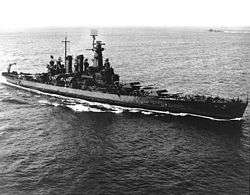
_before_World_War_II.jpg)
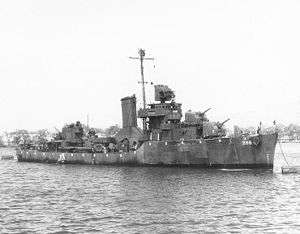
Rear Admiral William K. Harrill
1 fleet carrier:
- Essex (Capt. Ralph A. Ofstie)
- Air Group 15 (Cmdr. David McCampbell)
- 38 F6F Hellcat fighters (Lt. Cmdr. C.W. Brewer -- KIA)
- 36 SB2C Helldiver dive bombers (Lt. Cmdr. J.H. Mini)
- 15 TBF Avenger, 5 TBM Avenger torpedo bombers (Lt. Cmdr. V.G. Lambert)
- 4 F6F-xN Hellcat night fighters (Lt. R.M. Freeman)
- Air Group 15 (Cmdr. David McCampbell)
2 light carriers:
- Langley (Capt. W.M. Dillon)
- Air Group 32 (Lt. Cmdr. E.C. Outlaw)
- 23 F6F Hellcat fighters (Lt. Cmdr. Outlaw)
- 7 TBF Avenger, 2 TBM Avenger torpedo bombers (Lt. D.A. Marks)
- Air Group 32 (Lt. Cmdr. E.C. Outlaw)
- Cowpens (Capt. H.W. Taylor)
- Air Group 25 (Lt. Cmdr. R.H. Price)
- 23 F6F Hellcat fighters (Lt. Cmdr. Price)
- 3 TBF Avenger, 6 TBM Avenger torpedo bombers (Lt. R.B. Cottingham, USNR)
- Air Group 25 (Lt. Cmdr. R.H. Price)
3 light cruisers:
1 anti-aircraft light cruiser[lower-alpha 3]:
- San Diego (Capt. L.J. Hudson)
14 destroyers:
- 6 Fletcher class (5 x 5 in. main battery): Charles Ausburne, Stanly, Dyson, Converse, Spence, Thatcher
- 1 Mahan class (5 x 5 in. main battery): Case
- 3 Gleaves class (4 x 5 in. main battery): Lansdowne, Lardner, McCalla
- 4 Benham class (4 x 5 in. main battery): Lang, Sterett, Wilson, Ellet
Task Group 58.7
Vice Admiral Willis Augustus Lee
7 fast battleships
- Battleship Division 6 (Vice Admiral Lee)
- Battleship Division 7 (Rear Admiral O.M. Hustvedt)
- 2 Iowa class: Iowa, New Jersey
- Battleship Division 8 (Rear Admiral G.B. Davis)
- Battleship Division 9 (Rear Admiral E.W. Hanson)
- 2 South Dakota class: South Dakota, Alabama
4 heavy cruisers:
- Wichita (Capt. J.J. Mahoney), Minneapolis (Capt. Harry Slocum), New Orleans (Capt. J.E. Hurff), San Francisco (Capt. H.E. Overesch)
14 destroyers:
Notes
- These cruisers were intended as destroyer leaders when designed. After the first two to be used in this role, Atlanta and Juneau, were lost at the Naval Battle of Guadalcanal, this mission was rejected and the anti-aircraft mission adopted.[4]
- These cruisers were intended as destroyer leaders when designed. After the first two to be used in this role, Atlanta and Juneau, were lost at the Naval Battle of Guadalcanal, this mission was rejected and the anti-aircraft mission adopted.[4]
- These cruisers were intended as destroyer leaders when designed. After the first two to be used in this role, Atlanta and Juneau, were lost at the Naval Battle of Guadalcanal, this mission was rejected and the anti-aircraft mission adopted.[4]
References
- Morison 1953, pp. 277-278
- Morison 1953, pp. 416-417
- Morison 1953, pp. 412-415
- Stille 2016, p. 7
Bibliography
- Morison, Samuel Eliot (1953), New Guinea and the Marianas, March 1944 – August 1944, History of United States Naval Operations in World War II, VIII, Boston: Little, Brown and Co.
- Stille, Mark (2016). US Navy Light Cruisers, 1941-45. Oxford: Osprey Publishing, Ltd. ISBN 978-1-4728-1140-0.